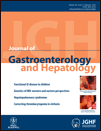Functional gastrointestinal disorders in adolescents and quality of school life
Abstract
Background and Aim
The prevalence of functional gastrointestinal disorders (FGID) in adolescents and their relationship to quality of school life (QOSL) are not fully understood. This study investigated the relationship between FGID and QOSL.
Methods
Adolescents (10–17 years) were recruited from 40 schools. FGID diagnoses were based on the Questionnaire on Pediatric Gastrointestinal Symptoms-Rome III version (QPGS-RIII). QOSL was evaluated by a questionnaire and calculated as the QOSL score.
Results
Five hundred and fifty-two of the 3976 students (13.9%) met the FGID criteria for one or more diagnoses according to the QPGS-RIII: 12.3% met the criteria for one, 1.5% for two or more. Irritable bowel syndrome (IBS) was the most common diagnosis (5.9%) followed by functional abdominal pain (3.1%). The prevalence of FGID was significantly higher in the female students in comparison to male students (P < 0.01). The prevalence of FGID was 9.5% in elementary school, 15.4% in junior high school, 26.0% in high school students, respectively. The prevalence of FGID was significantly increased with age (P < 0.01). The QOSL score of the patients with FGID was 10.9 ± 4.5 and that without FGID was 8.2 ± 2.8, respectively. The QOSL score of the patients with FGID was significantly worse than those without FGID (P < 0.01). The QOSL scores with IBS, aerophagia, and cyclic vomiting syndrome were significantly worse among the FGID (P < 0.01).
Conclusions
The prevalence of FGID in adolescents was relatively high. The presences of FGID worsen the QOSL score. Medical intervention and/or counseling are needed for such students to improve the QOSL.




